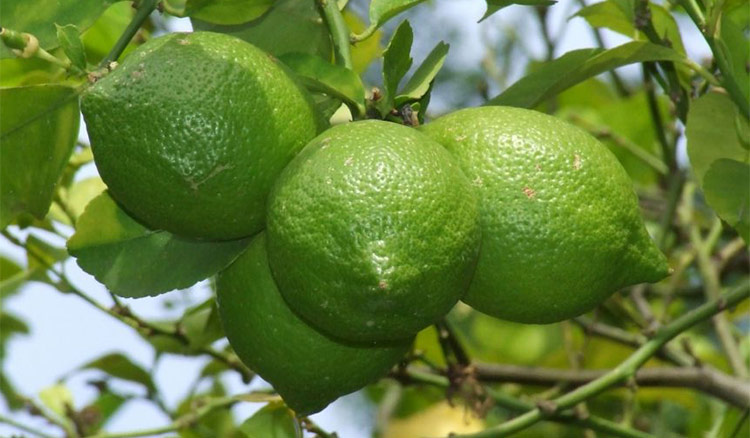Lime Essential Oil
Citrus aurantifolia

Description
Lime Essential Oil is amongst the most affordable of essential oils and is routinely used for its energizing, fresh and cheerful aroma. It is well known in folklore for its ability to cleanse, purify and renew the spirit and the mind. It is also said to be effective in cleansing the aura.
Though it's not on my list of top therapeutic oils, Lime Oil is one that I would be disappointed to live without. Its sweet yet tart, citrusy aroma blends well with so many other oils. Its aroma is especially concentrated, and a little goes a very long way. With the exception of floral Neroli Essential Oil, cold pressed Lime Essential Oil may be the most aromatically potent of the fruity citrus oils.

Including a few drops of Lime Essential Oil is a must when I create citrus blends for my diffuser or for when creating room mists.
Cold pressed Lime Essential Oil is phototoxic. Refer to the safety information mentioned below.
Lime Essential Oil Benefits and Uses
- Acne
- Asthma
- Chilblains
- Colds
- Dull Skin
- Flu
- Varicose Veins
Source: Julia Lawless, The Encyclopedia of Essential Oils (Updated Edition) (London: Harper Thorsons, 2014), 125.
Botanical Name
Plant Family
Common Method of Extraction
Cold Pressed/Expressed
Plant Part Typically Used
Color
Light Green With a Hint of Orange/Yellow
Consistency
Thin
Perfumery Note
Top
Strength of Initial Aroma
Medium
Aromatic Description
Lime Essential Oil smells fresh, citrusy, sweet and slightly tart.
Major Constituents
- a-Pinene
- B-Pinene
- Sabinene
- Myrcene
- Limonene
- y-Terpinene
- Terpinolene
- Octanal
- Nonanal
- Tetradecanal
- Pentadecanal
- Trans-a-bergaptene
- Caryophyllene
- B-bisabolene
- Geranial
- Neryl Acetate
- Geranyl Acetate
- a-Terpineo
- Linalool
Sources: B. Lawrence. Lime Oil (Perfumer & Flavorist 31, August/September 1987), 31, cited in Salvatore Battaglia, The Complete Guide to Aromatherapy (Australia: The Perfect Potion, 1997), 177.
Lime Essential Oil Safety Information
Cold pressed Lime Essential Oil is phototoxic. Steam distilled Lime Oil is not phototoxic. Tisserand and Young recommend a dermal maximum of 0.7% for the cold pressed oil to avoid the risk of a phototoxic reaction. They precaution to avoid topical use of Lime Oil, regardless of method of distillation, if it has oxidized. Reading Tisserand and Young's full profile is recommended. [Robert Tisserand and Rodney Young, Essential Oil Safety (Second Edition. United Kingdom: Churchill Livingstone Elsevier, 2014), 87, 336-338.]
General Safety Information
Do not take any oils internally and do not apply undiluted essential oils, absolutes, CO2s or other concentrated essences onto the skin without advanced essential oil knowledge or consultation from a qualified aromatherapy practitioner. For general dilution information, read AromaWeb's Guide to Diluting Essential Oils. If you are pregnant, epileptic, have liver damage, have cancer, or have any other medical problem, use oils only under the proper guidance of a qualified aromatherapy practitioner. Use extreme caution when using oils with children and be sure to first read the recommended dilution ratios for children. Consult a qualified aromatherapy practitioner before using oils with children, the elderly, if you have medical issues or are taking medications. Before using this or any essential oil, carefully read AromaWeb's Essential Oil Safety Information page. For in-depth information on oil safety issues, read Essential Oil Safety by Robert Tisserand and Rodney Young.
Shelf Life
Important Information About the Profiles
The essential oil information provided on AromaWeb is intended for basic educational purposes only. The references to safety information, test results, constituents and percentages is generalized information. Essential oils can vary greatly in composition. The data is not necessary complete and is not guaranteed to be accurate. The essential oil photos are intended to represent the typical and approximate color of each essential oil. However, essential oil composition and color can vary based on harvesting, distillation, age of the essential oil and other factors. Profiles for several CO2 Extracts and absolutes are included within the directory, and are denoted as such.
